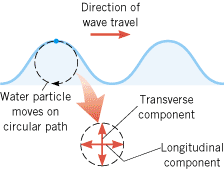Water waves have two features common to all waves:
| | 1. |
A wave is a traveling disturbance.
|
| | 2. |
A wave carries energy from place to place.
|
In Figure 16.1 the wave created by the motorboat travels across the lake and disturbs the fisherman. However, there is no bulk flow of water outward from the motorboat. The wave is not a bulk movement of water such as a river, but, rather, a disturbance traveling on the surface of the lake. Part of the wave’s energy in Figure 16.1 is transferred to the fisherman and his boat.
 | | Figure 16.1
The wave created by the motorboat travels across the lake and disturbs the fisherman. |
|
We will consider two basic types of waves, transverse and longitudinal. Figure 16.2 illustrates how a transverse wave can be generated using a Slinky, a remarkable toy in the form of a long, loosely coiled spring. If one end of the Slinky is jerked up and down, as in part a, an upward pulse is sent traveling toward the right. If the end is then jerked down and up, as in part b, a downward pulse is generated and also moves to the right. If the end is continually moved up and down in simple harmonic motion, an entire wave is produced. As part c illustrates, the wave consists of a series of alternating upward and downward sections that propagate to the right, disturbing the vertical position of the Slinky in the process. To focus attention on the disturbance, a colored dot is attached to the Slinky in part c of the drawing. As the wave advances, the dot is displaced up and down in simple harmonic motion. The motion of the dot occurs perpendicular, or transverse, to the direction in which the wave travels. Thus, a transverse wave is one in which the disturbance occurs perpendicular to the direction of travel of the wave. Radio waves, light waves, and microwaves are transverse waves. Transverse waves also travel on the strings of instruments such as guitars and banjos.
 | | Figure 16.2
(a) An upward pulse moves to the right, followed by (b) a downward pulse. (c) When the end of the Slinky is moved up and down continuously, a transverse wave is produced. |
|
A longitudinal wave can also be generated with a Slinky, and Figure 16.3 demonstrates how. When one end of the Slinky is pushed forward along its length (i.e., longitudinally) and then pulled back to its starting point, as in part a, a region where the coils are squeezed together or compressed is sent traveling to the right. If the end is pulled backward and then pushed forward to its starting point, as in part b, a region where the coils are pulled apart or stretched is formed and also moves to the right. If the end is continually moved back and forth in simple harmonic motion, an entire wave is created. As part c shows, the wave consists of a series of alternating compressed and stretched regions that travel to the right and disturb the separation between adjacent coils. A colored dot is once again attached to the Slinky to emphasize the vibratory nature of the disturbance. In response to the wave, the dot moves back and forth in simple harmonic motion along the line of travel of the wave. Thus, a longitudinal wave is one in which the disturbance occurs parallel to the line of travel of the wave. A sound wave is a longitudinal wave.
 | | Figure 16.3
(a) A compressed region moves to the right, followed by (b) a stretched region. (c) When the end of the Slinky is moved back and forth continuously, a longitudinal wave is produced. |
|
Some waves are neither transverse nor longitudinal. For instance, in a water wave the motion of the water particles is not strictly perpendicular or strictly parallel to the line along which the wave travels. Instead, the motion includes both transverse and longitudinal components, since the water particles at the surface move on nearly circular paths, as Figure 16.4 indicates.
 | | Figure 16.4
A water wave is neither transverse nor longitudinal, since water particles at the surface move clockwise on nearly circular paths as the wave moves from left to right. |
|
 |
| Copyright © 2000-2003 by John Wiley & Sons, Inc. or related companies. All rights reserved. |




